Using YouTube to Grow a Business

Most people are afraid to use YouTube to promote their business. But you shouldn’t be and here’s why: the most popular videos aren’t professional productions. They’re just a girl or guy, that gets in front of a camera and talks about what he/she knows best. No expensive equipment required.
However, YouTube is one of the biggest and most popular social networks in the world – in fact, it’s the second biggest website in the world.
Here are some of my favorite tips for using YouTube to promote your business.
See you on the action-field,
Raksha Sukhia, SMB Growth Expert,
Founder BBR Network. #bbrnetwork
Wondering if your business should have a YouTube presence? Have you tried publishing on YouTube but it hasn’t done anything for your business?
In this article, you’ll learn how to use YouTube videos to grow your business organically.
Why Businesses Should Consider YouTube
There are two key reasons businesses should consider marketing on YouTube.
The first is the SEO benefits. While YouTube itself can help reach your target audience, combining it with the power of its parent company Google can give you an SEO boost. Let’s say you have a YouTube video that’s performing well and uses well-researched keywords. If you embed it in a blog post with similar keywords, it can drive up the potential for both pieces of content to reach their objectives.
Embedding a YouTube video into a blog post can also boost time on site, which is an important signal to Google that it’s a quality piece of content. If people start spending more time than average on an article with an embedded video, that’s going to help both the article and the video.
If you create content in both the written word and video, the combination can be very powerful. It doesn’t matter whether you create the video or the blog post first—everybody’s brain works differently so choose the approach that works for you. It’s an easy way to create two forms of content that are both going to help you.
The other key benefit to YouTube is the longevity of the content. For most of social media, your content’s shelf life is brief, but on YouTube, your content can be consumed for years to come. You can publish a video today that doesn’t perform well, but in a year or two, it may take off. Someone today could be watching one of your videos from 2 years ago and be turned onto you as a brand.
Jessica did a video about iMovie 3 years ago that’s still in her top 10 today. Older videos like that are continuing to help her grow her list and get in front of people she wouldn’t have been able to reach otherwise.
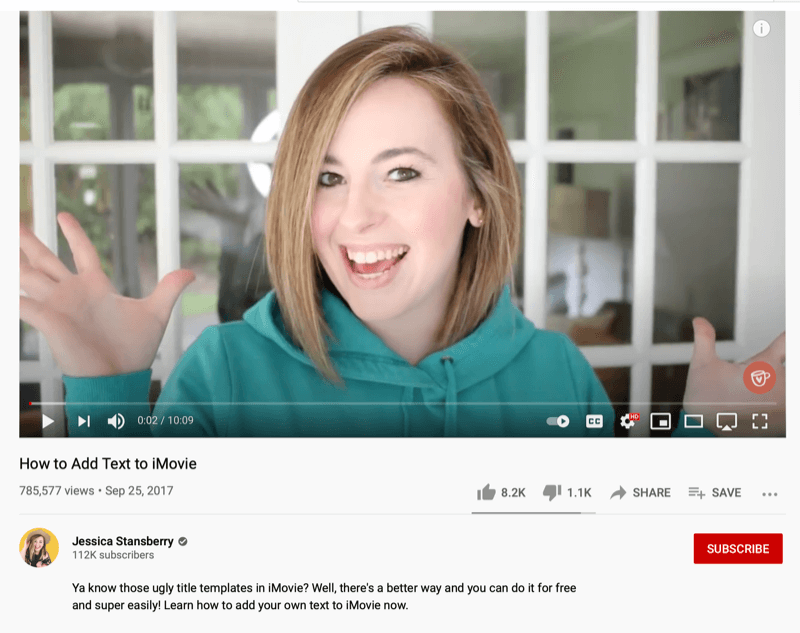
YouTube is a content machine. They want users to stay on the platform so they continually suggest additional videos for viewers to watch. They know when someone’s watching a video on Clubhouse, for instance, that they might want to watch another video on Clubhouse. If your video is included in suggested content, you can reach a massive new audience that you might not be able to reach otherwise. It’s amazing how long the tail is on YouTube content.
YouTube Can Work for Any Business
Almost any kind of business can benefit from YouTube. For instance, a real estate agent in Tennessee, which is obviously a location-specific business, made YouTube work for her. She created a strategy where she starting sharing her expertise in topics such as how to buy a house and answering questions like, “What is escrow?” Later, she ended up building out courses and education in that niche but YouTube helped her become a go-to resource.
As her channel grew, her brand grew. People from her area started recognizing her because they found her on YouTube as they were searching for answers to questions she was answering in her content. She was able to rank for “real estate agent in Nashville, Tennessee” because she leveraged the SEO benefit. YouTube helped her not only grow the local side of her business but also hit record numbers on the education side.
Roger Wakefield, a plumber in Texas, started a YouTube channel for a similar reason: to improve his SEO and help people find him. In the beginning, his YouTube channel didn’t do much for his business but it eventually took off.
Then a national plumbers’ association asked him to start speaking and he began training other plumbers on how to get into the plumbing business.
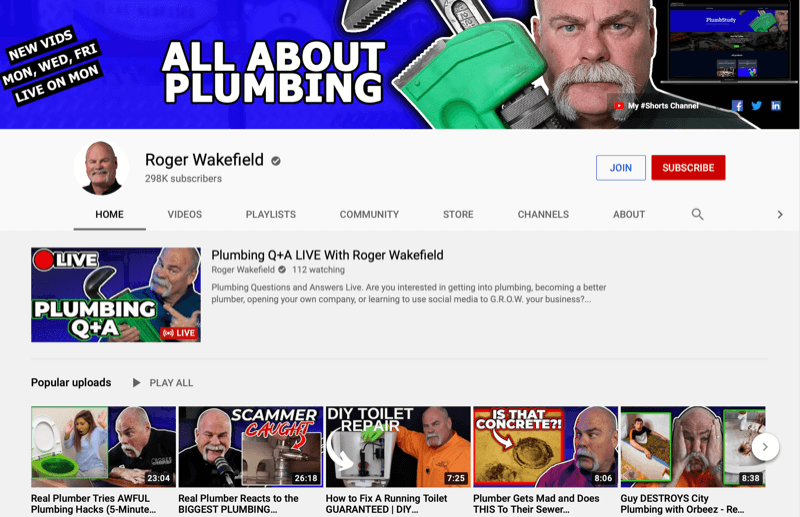
#1: How to Avoid the Biggest Mistake Marketers Make on YouTube
The YouTube algorithm’s job is to pair the right viewer with the right content so the viewer stays on the platform. If you’re sending people off of the platform too much, YouTube will look unfavorably upon that. You might still be able to grow your business from YouTube but not at the rate you could be if you took your foot off the gas a bit.
Remember, YouTube is a business. They have advertisers that pay them billions of dollars and they need to keep them happy. If you’re constantly sending people off of the platform, YouTube will diminish your reach and your videos won’t be seen as much. If you look at your analytics, you may see that people are viewing your content and you’re doing everything right, but it can be problematic if they’re not extending their session on the platform.
At this point, you might be thinking, “I work for a business and my job is to sell the business. How’s that going to work?”
What it comes down to is the same thing as with any social media platform. If you’re constantly on Instagram asking people to buy your products, that’s not an effective strategy. A better approach is a soft sell. Eighty percent of the time, your YouTube content should be about giving to your audience—teaching, helping, and providing value—which will help build your brand. The other 20% of the time, you can ask your audience for something.
While 80% of your videos may not get people to download your freebie or buy your product, they prove to YouTube that your content can keep people on the platform. This mitigates the impact of the 20% of videos where you ask viewers for something.
In your 20% where you’re hard-selling those opt-ins, you can tell readers to go click on this link and display cards in your video that people can click. Just make sure you only use endcards and endscreens when you’re doing the hard sell, not in the 80% where you’re giving to your audience. That way it won’t hurt your analytics too much.
#2: How to Do a Soft Pitch on YouTube
To do a soft pitch on YouTube, you might include an opt-in or freebie link on your About tab or in the video description. It’s a soft ask because you’re not physically sending people somewhere from within the video or disrupting the viewing session. They’re making that decision by digging deeper, going to the description, your channel page, or your About tab.
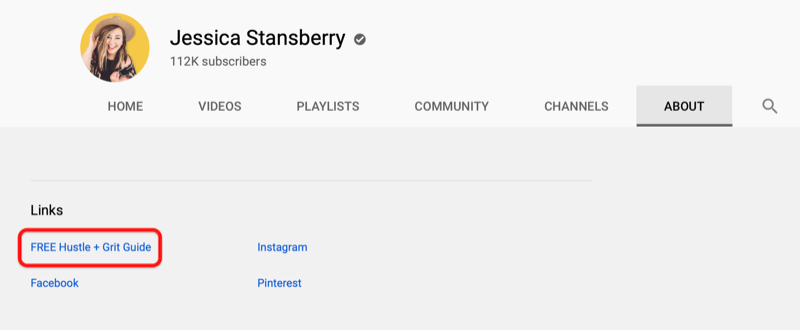
You can also put the link to your opt-in right on your YouTube cover image. Replace the website link with a direct link to an opt-in that’s aligned with what your audience wants. Make sure that the image draws attention to it, such as with an arrow or a graphic of what they’re going to get. Jessica has seen her opt-in rate skyrocket from this technique.
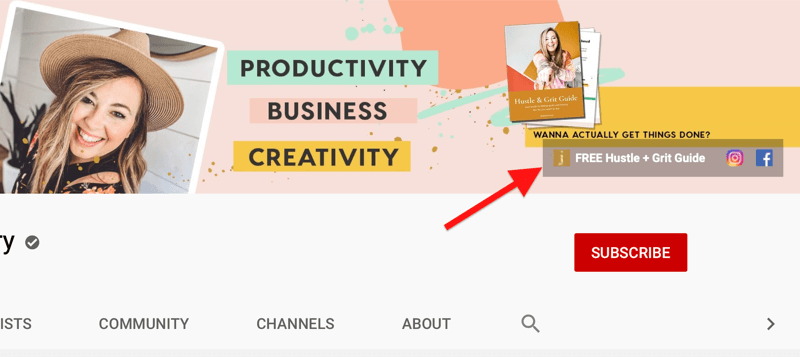
For all of your videos, make sure you mention things organically. As marketers, we sometimes forget we have resources that people actually want. In our heads, we’re focused on the one thing we want to mention but forget we have numerous other resources that our audience might need.
In your 80% videos where you shouldn’t be pitching and sending people off of the platform, you could say something like, “While I’m talking about [topic], I have a link below in the description where you can go check that out.” Just don’t pop it across the screen or draw a ton of attention to it because that would send viewers off the video with an easy click. Plus, because people have to work to get to your opt-in page to sign up, it’s a way to vet the people on your email list.
#3: How to Do a Hard Ask on YouTube
In the 20% of your videos where you do the hard ask, start by making sure the topic is going to do well on its own. Your YouTube analytics should give you a sense of what content will perform well with your audience. It needs to be a video you expect to do well because you’re already stacking the deck against it by sending people off of the platform with a hard ask.
Next, if possible, create or choose an opt-in that’s specific to the topic of that video, not just a generic opt-in you want to promote.
For instance, Jessica did a Trello tutorial a few years ago, and at the beginning of the video (after the standard hook and intro), she said, “We’re going to talk about Trello in this video. A lot of people have a hard time figuring out exactly how to make it work for them, so I’ve created some templates you can download for Trello. To grab those, you want to go to [website].”
She did it at the beginning and end and linked it in cards and the description. The freebie also fit really well with the topic.
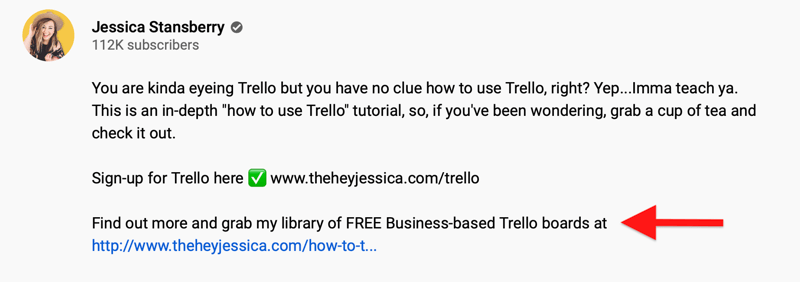
In addition to a clickable link on the card, it’s also helpful to put the URL across the screen and tell viewers that the link is in the description because mobile users might have a hard time clicking on the card or seeing the URL.
At the end of the video, you can make your hard ask part of your closing statement (in the last 20 seconds or so). Where normally you might wrap things up and ask viewers to subscribe, remove that piece and throw in another: “Don’t forget, grab these templates that I’ve created.” Pop the URL on the card, put another URL across the screen, and tell them again about the link in the description. That way, it’s a hard ask.
There’s also an opportunity to sell directly on YouTube; however, it shouldn’t be something expensive like a $1,000 course. Rather, selling low-cost offers is a no-brainer as long as it’s in the 20% of your 80/20 split. Jessica has had a lot of success selling low-cost offers directly from YouTube videos. But again, the ask needs to be paired with a video you know is going to do well.
For example, Jessica did a video about GoodNotes for iPad, which is a digital planner that works similarly to a paper planner with clickable tabs for easy navigation. She knew a video on this topic would perform well with her audience on YouTube and there weren’t a lot of competing how-to videos on the topic.
Before she published the video, she designed her own planner, which she then used in the tutorial. She knew her audience would be interested in her planner so this was a hard sell video: “By the way, this is a planner I designed. I’ll put the link below.” Within its first 2 months, that video not only increased her subscriber rate significantly but she also earned $10,000 in revenue from that $27 product.
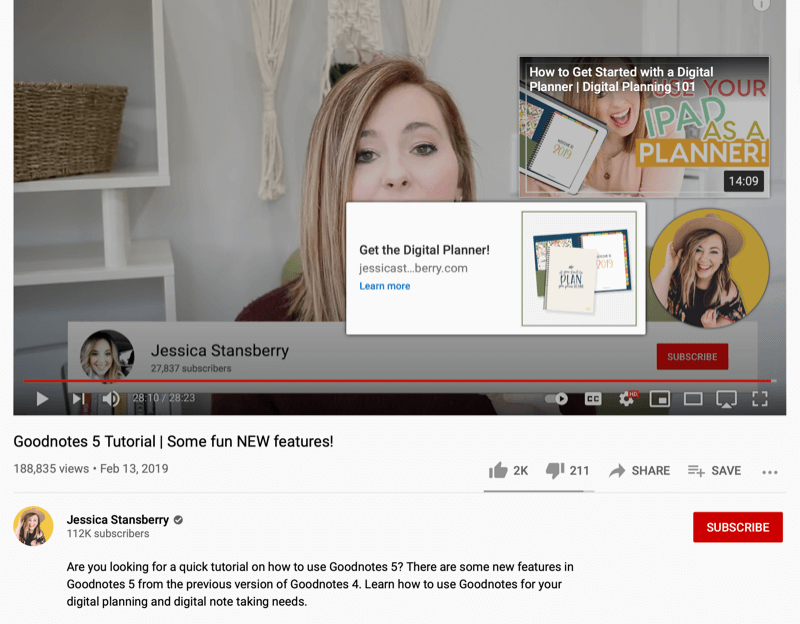
If your YouTube channel is in a growth phase right now and you’re doing 100% give videos, how would you flip the switch and start doing some of the 20% videos? In all of your YouTube videos, you want to include a call to action. Most of the time, it’s a YouTube-specific call to action—subscribe, thumbs up, comment. When you start doing 20% videos, replace those calls to action with your hard ask and actually tell viewers to click the link in the card (or the description) to get the freebie.
You can say, “I created this free guide. Go to [this address] to get it.” That’s when you’ll really see an impact.
Related Article
What’s a Good Landing Page Conversion Rate?
Business Agility Is the New Norm. Do You Have What It Takes?
Tags
#BBR Network, #LinkedIn #Social Media Marketing, #Profitability, #Small Business Growth, #Small Business Marketing and Sales, #SMB, #SME, B2B, Build Business Results, Build Business Results (BBR), Build Business Results (BBR) Mastermind.










